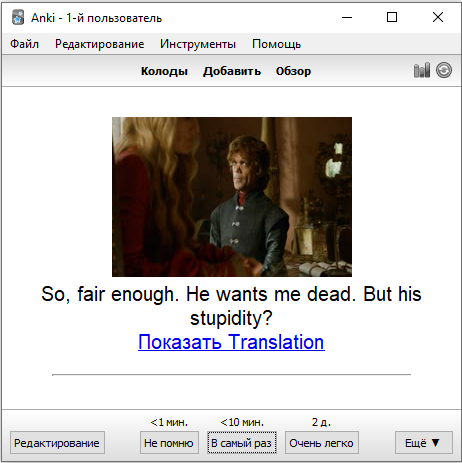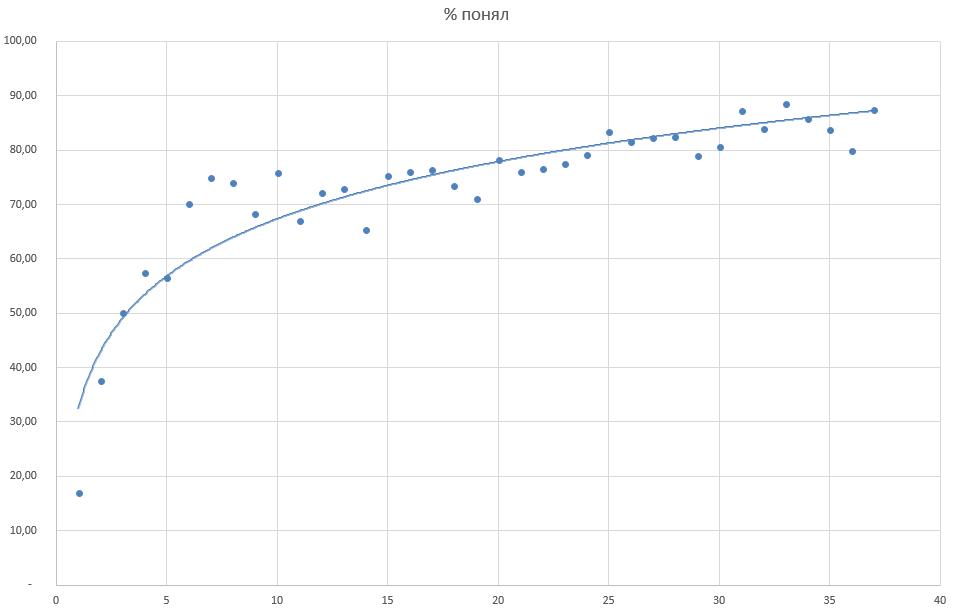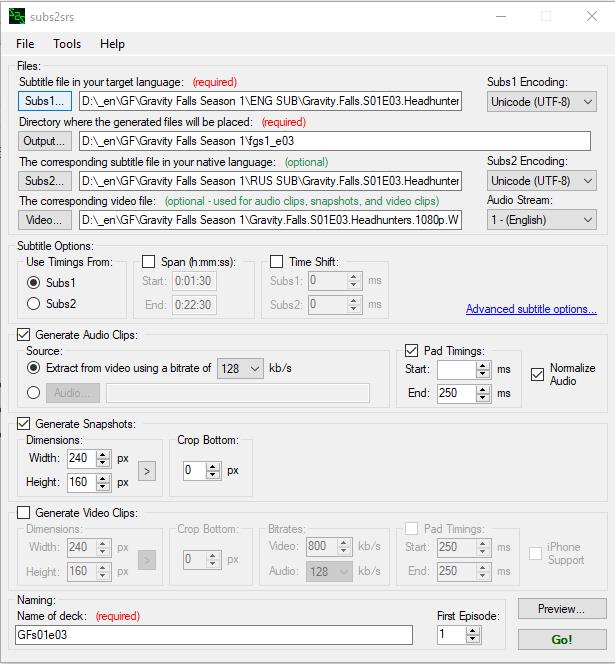
At the beginning of my studies, I was trying to find a magical way that would allow me to learn English without learning English. Gradually, I began to come to the realization that there is no magic way, but some learning approaches are more effective. For me this approach turned out to be the spaced repetition method, in particular the Anki program . This is a program for memorizing any information by repeating it at certain time intervals.
With her help, I doubled my vocabulary, became more confident in reading texts. Disappointment befell me when I decided to be like speaking English courses - I realized that I understand about 50% by ear. After that, I started trying to watch TV shows, I realized that I understand even less than in the courses. The problem became obvious, but its solution was not very good.
How the method evolved
It was clear that in order to understand better by ear, one had to listen more. But I noticed that if I didn’t understand some expression by ear, then I won’t understand the same expression the next time. How to solve the problem, this article suggested .
The basic idea is that spaced repetition works well with audio.
I decided to create cards with Anki that will play audio. I decided to take the content from the series, since any famous series has both English and Russian subtitles and a time reference to the audio. It remains only to pluck what you need from the video file and the file with subtitles and assemble it into Anki cards.
The choice fell on the animated series "Gravity Falls" from Disney. It was very inconvenient to create cards: I opened Russian and English subtitles in two notebooks, an audio track in an audio editor, and then I also added an image with a frame to the card from the place in the film where the audio fragment was taken from.
Despite the huge inconvenience when creating cards, already in the second series I began to understand a lot more. As a bonus, the episodes that I worked in this way looked and then just as easy as in my native language. And it also became obvious that you need to automate the creation of cards.
Hastily wrote a program that simplified the process of creating cards. With her help I worked both seasons of “Gravity Falls”. After Gravity Falls, the animated series Futurama and Adventure Time were easy to listen to. It became clear that the teaching method was effective, but the process of creating cards was inconvenient and lengthy. Quite by accident, on some forum, I found a mention of the Subs2srs program , which saved me from all the routine work and finally formed the entire learning algorithm.
After “Gravity Falls” I decided that I would further develop my listening skills from “Game of Thrones”. It was not the best choice, but more on that later. With the help of Subs2srs I created something like an audio comic strip.

All cards were arranged in the same sequence as the fragments in the series. I watched a picture from a specific moment and listened to an audio track from the same moment. Then I looked at the answer: if I understood the essence of the phrase (exactly the essence, and not literally), then I deleted this card; if he did not understand (or did not understand correctly), he put the card aside for further study. Each time I wrote down how many cards in the series were in total and how many cards I could not hear. Accordingly, I could see my progress. After that, I memorized phrases in Anki, along the way adding flashcards with unknown words. Having learned all the flashcards from the episode, I finally watched the episode that I was studying. Then everything was repeated with the next series.
From my notes on the number of phrases understood in the series, I could monitor the progress. At first it goes very fast, then it slows down. I never managed to achieve more than 90% understood phrases. The first few episodes of a new series are always difficult. After the American pronunciation in "Gravity Falls" I understood almost nothing in the first episode of "Game of Thrones". But then I got used to the voices a little, and the Lannisters drove up, and everything quickly went uphill.

The graph shows that it would be enough to watch the first 20 - 25 episodes. There is almost no further progress.
Main conclusions
- Audio cards are remembered much faster than a card with a single word. Here everything, as I understand it, is decided by the context: even if you do not know the translation of a single word, you can understand it in the context of the entire phrase.
- : , , , . .
- Subs2srs . . : , , .
- ( 15 ), , , . , , .
- . . . , .
- . , . , , , . , .
- () “Game of Thrones”, 80% . , , . . , , .
- . . , . , . . “Game of Thrones”, , : , , , .
- , .
- ANKI . , , . , . . , .
- .
- .
- , subs2srs.
- Anki, .
- , , . ( Anki).
- We study in Anki all the phrases that remained unclear. We add unfamiliar words from phrases for additional memorization.
- About a week after viewing the last card, we turn on the studied series and enjoy watching.
- We repeat the whole algorithm, starting from the second point, with the next series.
Decks
If you do not want to create decks yourself, here are several ready-made ones. Just open them in Anki and follow the above algorithm, starting from point 4.
How to use Subs2srs
There is a lot of information about Anki. But Subs2srs is a little-known program, so I'll tell you how it works.
And so we decided on what we would watch. We need: a video file with an English track, Russian and English subtitles (the program can extract subtitles from .MKV). Everything is quite simple here: we indicate the location of the subtitle folder and the place where the files will be saved. It is worth paying attention to the Pad Timings item: here you can adjust the delay if the audio does not fall into the subtitles. Normalize Audio makes quiet parts louder. A must before pressing Go! go to Preview and check if the audio gets into the subtitles. If it misses, correct it in Pad Timings. Then click Go! And we are waiting for completion. At the output, we get a file for import and a picture with frames from the movie.
We import text and media files into Anki, into a separate deck. Subs2srs creates a .tsv import file + audio files and images that we need to add to our deck. First, we import the created .tsv file, then copy the generated audio files and pictures into the “collection.media” folder. At the exit, we get a deck from which we will learn.

There were times when I could not find normally timed subtitles. In my experience, this is often the case with older movies and TV shows. For example, I never found any good subtitles for Friends and Avatar: The Last Airbender. It's a shame both shows are great for beginners.
What to watch
I will repeat again about the choice of the series. Everything is simple, the show must be interesting (this is the most important thing). It's great if the episodes are short. Desirable with modern slang and phrases. Game of Thrones is not the best choice in almost all respects.
I usually recommend:
Gravity falls
Silicon valley
Arrow
A Series of Unfortunate Events
Strange things
Louie (the simplest series I've watched)
Cobra Kai
If you know any simple series that are not on this list, write me, I will complete the list.